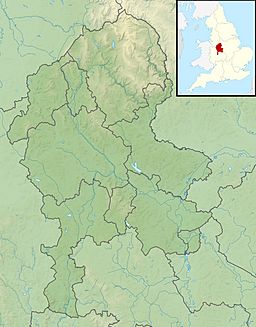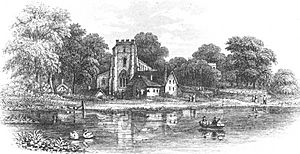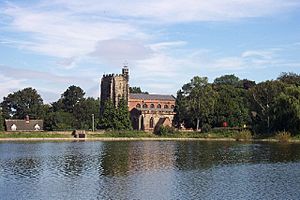Stowe Pool facts for kids
Quick facts for kids Stowe Pool |
|
|---|---|
 |
|
| Location | Lichfield, Staffordshire |
| Coordinates | 52°41′18″N 1°49′22″W / 52.688384°N 1.822799°W |
| Type | reservoir |
| Primary inflows | Leamonsley Brook, Trunkfield Brook from Minster Pool |
| Primary outflows | Curborough Brook |
| Catchment area | 37.2 km2 (14.4 sq mi) |
| Basin countries | England |
| Managing agency | Lichfield District Council |
| Built | 1856 |
| Max. length | 470 metres (1,540 ft) |
| Max. width | 100 metres (330 ft) |
| Surface area | 55,000 square metres (14 acres) |
| Average depth | 3.95 metres (13.0 ft) |
| Max. depth | 7 metres (23 ft) |
| Water volume | 217,600 m3 (47.9×106 imp gal; 176.4 acre⋅ft) |
| Shore length1 | 1.13 kilometres (0.70 mi) |
| Surface elevation | 79.3 m (260 ft) OD |
| 1 Shore length is not a well-defined measure. | |
Stowe Pool is a cool reservoir located in the city of Lichfield, Staffordshire. A reservoir is like a big, artificial lake used to store water. For a long time, Stowe Pool was a place where people fished. It was also a mill pond, helping power a mill nearby.
In 1856, it was officially turned into a reservoir by a water company. Since 1968, it hasn't been used for drinking water. Instead, it's a fun public spot for different activities. Stowe Pool is also a very special place because it's home to rare white-clawed crayfish. Because of these crayfish, it's called a SSSI.
Contents
How Water Flows in Stowe Pool
Stowe Pool gets its water from two streams. These streams are called Leamonsley Brook and Trunkfield Brook. They flow from the west side of Lichfield.
The water travels underground for a bit. It then flows into Minster Pool. After that, it goes through pipes and into Stowe Pool. The water that leaves Stowe Pool flows north as Curborough Brook. This brook eventually joins the River Trent.
Stowe Pool can hold a lot of water. It has a capacity of about 217,600 cubic meters. That's like 47.8 million gallons! The surface of the pool covers about 55,000 square meters. Its average depth is around 3.95 meters.
Amazing Animals and Plants
Stowe Pool is full of life! It's home to many different kinds of fish. You can find carp, bream, and tench here. There are also roach, perch, pike, and eel.
White-Clawed Crayfish: A Special Resident
One of the most important animals in Stowe Pool is the white-clawed crayfish. These crayfish are very special. They are not exposed to diseases that have harmed crayfish in other places. Because of this healthy population, Stowe Pool became an SSSI site in 1998. This means it's a protected area.
Birds and Water Plants
The pool's good care has attracted many types of wild birds. You can see beautiful swans gliding on the water. There are also moorhens, coots, and grebes.
The edges of the pool don't have many plants. But in the water, you can find Polygonum amphibium. There's also spiked water-milfoil. The shallow parts of the pool have a rare water plant. It's called Chara aspera var. curta. This plant is a type of stonewort.
Stowe Pool Through Time
Stowe Pool has a long and interesting history. It was first created way back in the 11th century. This happened when a dam and a mill were built. They were placed across Leamonsley Brook near St Chad's Church.
The Old Mill and Fishery
The original mill belonged to the Bishop of Lichfield. It helped him earn money from the city. The mill was used to grind wheat and other grains. It kept working until it was taken down in 1856. Over the years, the mill was rebuilt many times. By the 18th century, it had three water wheels!
The pool was also a very important place for fishing in the 13th century. The Bishop of Lichfield owned the fishery. Later, in the 16th century, the city took over. They then let people fish there until 1856.
Samuel Johnson and the Willow Tree
In the 18th century, a famous writer named Samuel Johnson often visited the pool. His father had a factory nearby. It made parchment, which is a type of paper. There was a huge willow tree by the pool. It became very famous because of its size. Johnson loved this tree and visited it whenever he came back to Lichfield. Because of his interest, it was called 'Johnson's Willow'. The tree there today is a descendant of the original.
From Bog to Beautiful Reservoir
By the 1800s, parts of Stowe Pool had become muddy. The western side was a bog known as ‘the moggs’. The pool was also used as a sewer. Waste from local leather factories flowed into the water. In the 1840s, people worried about the health risks. There was even a plan to fill the pool in completely.
But things changed in 1853. The South Staffordshire Waterworks Co. was started. They decided to use Lichfield's water to supply other areas. In 1856, the old mill was taken down. The mud was removed, and a new embankment was built. This raised the water level to its current size. A walking path was also built around the pool.
Pipes were laid to bring water from the streams into Stowe Pool. The stored water was then sent to a pumping station. From there, it was piped to Walsall.
A Place for Fun Today
In 1968, the city got the pool back. It was no longer needed for water supply. Now, Lichfield District Council keeps the pool for everyone to enjoy. They stock it with fish for people who like to fish. The pool is also used for water sports. You can see people sailing and canoeing there.
Images for kids
More Information
- List of reservoirs in Staffordshire
- List of reservoirs and dams in the United Kingdom
- List of Sites of Special Scientific Interest in Staffordshire
- List of lakes of England





